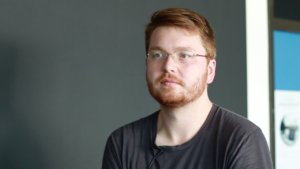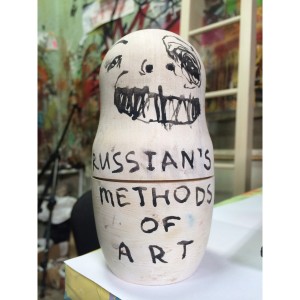Julius: The fields in which we are working do overlap and we are good friends which means that the same work ideas come into both of ours minds … and we also talk a lot about the work. Also, about those we do alone and sometimes you realise: okay, because we are so close to each other with this idea or the idea eventually comes up in a conversation, we simply carry it out together. Working together is a lot more fun than working alone. Although you always have got your helping assistants, working alone means that you carry the entire responsibility on your own and you can not really discuss the work with somebody. And if you’re working in pairs and you are unsure about something, you can discuss it and maybe find the solution in the debate. And that is of great value for me. It’s almost always the same, it is a great opportunity. You also learn a lot, because in discussions one really has to dispute with the other artists. This means you really have to find a way, so that both parts are happy with what you are doing there.
Julius: Felder, in denen wir arbeiten überschneiden sich. Wir sind gut befreundet und wir reden auch sehr viel über die Arbeiten. Auch über die, die wir alleine machen und manchmal merkt man dann halt: Okay, da sind wir so nah aneinander mit irgendeiner Idee oder die Idee entsteht im Gespräch zusammen, dass man die dann einfach zusammen umsetzt. Und zusammen zu arbeiten macht einfach auch wahnsinnig viel mehr Spaß als alleine zu arbeiten. Alleine hat man dann zwar seine Assistenten, die einem helfen aber man ist trotzdem immer alleine mit der Verantwortung und man kann nicht so richtig diskutieren mit jemandem, sondern man muss irgendwie immer selbst… und wenn man zu zweit arbeitet, dann kann man, wenn man sich unsicher ist, in einem Streitgespräch die Lösung finden. Und das ist für mich sehr wertvoll. Das ist eigentlich immer das gleiche, dass es eine große Chance ist. Man lernt auch sehr viel, weil man sich dann in den Diskussionen wirklich mit den anderen Künstlern auseinander setzten muss. Das heißt man muss wirklich einen Weg finden wie beide das toll finden, was man da macht.
Julian: I think we have made two artworks together. One was „Some Pigeons Are More Equal Than Others“. This was a series of works, because we have done it twice or almost three times now. This was in Berlin, Copenhagen and Venice. And by that our common interest was to work in the city space and also to make something technical: create a big impact with a small neck. We have coloured pigeons, to change the perception of the city and also the perception of pigeons and of course this was a lot of work. We are still working on it, because we are composing a book together right now and we will publish it soon. We just have done something together that really represents both of us quite well. And I haven’t got an authorship problem, for sure. Sometimes our interests and also our studio overlaps and therefore you are so close together which means you just have to work together sometimes. And we also travel a lot together and when you’re travelling, then you are in the pub and you’re drinking and then … it’s a bit of an artist cliché, but then we start discussing, and than you have an idea and the idea is great and in the end you don’t know who’s idea it actually was and eventually we realise the idea together. It’s a lot of fun. So we really did a lot together in Venice, in Copenhagen, and also in all of Africa and that’s how the work ideas arise.
Julian: Ich glaube wir haben zwei gemeinsame Arbeiten gemacht. Die eine „Some Pigeons Are More Equal Than Others“. Das war eine Reihe an Arbeiten, weil wir das jetzt zwei oder fast dreimal gemacht haben. Das war in Berlin, Kopenhagen und in Venedig. Und da war unser gemeinsames Interesse im Stadtraum zu arbeiten und auch etwas Technisches zu machen. Mit einem kleinen Ansatz eine große Wirkung erzeugen. Wir haben Tauben gefärbt, um die Stadtwahrnehmung und auch die Taubenwahrnehmung zu ändern und das war natürlich eine große Arbeit. Wir arbeiten immer noch daran, weil wir jetzt gerade auch ein Buch zusammen machen und bald heraus geben werden. Wir haben zu zweit etwas gemacht, das uns beide eigentlich ganz gut darstellt. Ich habe da auf jeden Fall kein Autorenschaftsproblem. Manchmal überlappen sich unsere Interesse und unser Studio auch und deswegen ist man so nah aneinander, das heißt man muss einfach manchmal arbeiten. Und wir reisen auch viel zusammen und wenn man reist, dann ist man in der Kneipe und dann trinkt man und dann – das ist auch ein bisschen dieses Klischeekünstlersein – aber dann diskutiert man, dann hat man eine tolle Idee und die Idee ist sau gut und dann weiß man gar nicht wer die Idee gehabt hat und dann machen wir die Idee zusammen. Das macht unglaublich viel Spaß. Wir waren zusammen in Venedig, in Kopenhagen und sind auch durch Afrika gereist. Wir haben immer viel zusammen gemacht und danach entstehen dann auch die Arbeiten.
Julius: Actually, it is really much more fun to work together on projects than alone. It works really really well! There is also a down-side, because the artist stereotype rather sees the artist as one person. As a genius but not as a group or as a duo. It is a bit difficult to convey this, because the people cannot classify very well what it means. When you have an interview about an artwork and you explain it and then you say: well, there is also another artist involved, but you can not really speak for him and those who interview you do not really know how to deal with it and how to write it down. And you always have the feeling that you do not fit into the stereotype where you belong to.
Julius: Eigentlich macht es wirklich mehr Spaß an Projekten zusammen zu arbeiten als alleine. Es funktioniert wirklich tatsächlich sehr gut! Es gibt auch einen Nachteil davon, weil eben das Künstlerklischee eher den Künstler als eine Person sieht. Als ein Genie und nicht als Gruppe oder als Paar. Das ist manchmal ein bisschen schwierig, das rüber zu bringen. Weil die Leute das halt nicht so gut einordnen können, was das bedeutet. Dann hat man ein Interview für so eine Arbeit und dann erklärt man eine Arbeit und dann sagt man: Ja, da ist auch noch ein anderer Künstler dabei, aber man kann ja nicht wirklich für den mitreden und die, die da einen interviewen die wissen auch nicht so richtig wie sie dann damit umgehen sollen und wie man das dann aufschreiben soll. Und man hat immer so das Gefühl es passt nicht so wirklich in das Klischee rein wo man reinpassen soll.
Julian: Regarding the communication it is actually quite difficult.
Julian: Für die Kommunikation ist es tatsächlich schwierig.
Julius: How intense one sticks to his or her idea and with which ideas you have to decide: this is a Julius von Bismarck idea, I need realize this on my own and which ideas are rather flexible ideas that just stand in the room or zeitgeist-things that just have to be done now and then you do them together, because it might not be a very personal work, but rather a work that is wanted badly and that you have to implement them. And these are the kind of works, you can do very well together.
Julius: Wie stark klebt man an seinen Ideen? Oder bei welchen Ideen entscheidet man, das ist eine Julius von Bismarck Idee, die muss ich unbedingt selbst alleine durchziehen. Und welche Ideen sind eher flüssige Ideen, die vielleicht sowieso gerade im Raum stehen? Oder so Zeitgeist-Sachen, die einfach jetzt gemacht werden müssen und dann macht man die zusammen, weil es vielleicht gar nicht eine sehr persönliche Arbeit ist, sondern eher eine Arbeit nach der es einfach gerade schreit und die man umsetzten muss. Und das sind solche Arbeiten, die man sehr gut zusammen machen kann.
Julian: Just after the revolution we travelled two months from Jordan to Egypt and Sudan with 5 people. These are really intense times, there is so much exchange that there certainly evolves a work project for two people or sometimes even with the others.
Julian: Wir sind etwa zwei Monate zu fünft von Jordanien, durch Ägypten in den Sudan, direkt nach der Revolution, gereist. Das sind so intensive Zeiten. Da gibt es so viel Austausch, dass sich am Ende ganz natürlich etwas zu zweit ergibt oder manchmal auch mit anderen zusammen.
Julius: Yes. For example the „nature graffiti-artwork“ came up when we were standing on top of a sand dune in the desert with a few spray cans and we thought: okay, what shall we spray on it? And then we thought: okay, we will spray “dune” (in German) onto the sand dune. And this was the birth of this community series and then we just inscribed plenty more places. I have worked together with Santiago Sierra, for example. Who belongs to a completely different generation than I do. Who has a completely different background and also a different position regarding the art market. I am at the very beginning and he is already very, very, very far away. And that was a very different cooperation but also very interesting. So there are very different things you take in somehow when you work together with another artist. But here again the difficulty that occurs afterwards is the media not knowing how to describe this properly.
Julius: Ja. Also die Naturgraffiti-Arbeit ist sozusagen geboren worden, als wir in der Wüste standen mit ein paar Sprühdosen auf der Düne stehend und gedacht haben: Okay, was schreiben wir jetzt hier auf die Düne drauf? Und dann haben wir irgendwann gedacht: Okay, wir schreiben da jetzt Düne drauf. Und das war dann die Geburt für diese Gemeinschaftsserie und dann haben wir halt noch sehr viel mehr Orte beschriftet. Ich habe zum Beispiel auch mit Santiago Sierra zusammen gearbeitet, der eine ganz andere Generation ist als ich. Der einen ganz anderen Hintergrund hat, ganz anders auch da steht gegenüber dem Kunstmarkt. Ich bin ganz am Anfang und er ist schon ganz, ganz, ganz weit. Und das war noch eine ganz andere Zusammenarbeit aber auch sehr interessant. Also eine ganz andere Sache, die man dann irgendwie mit aufnimmt, wenn man mit einem anderen Künstler zusammen arbeitet. Aber auch da wieder die Schwierigkeit, dass die Medien dann nachher nicht wissen wie sie es richtig darstellen sollen.

















